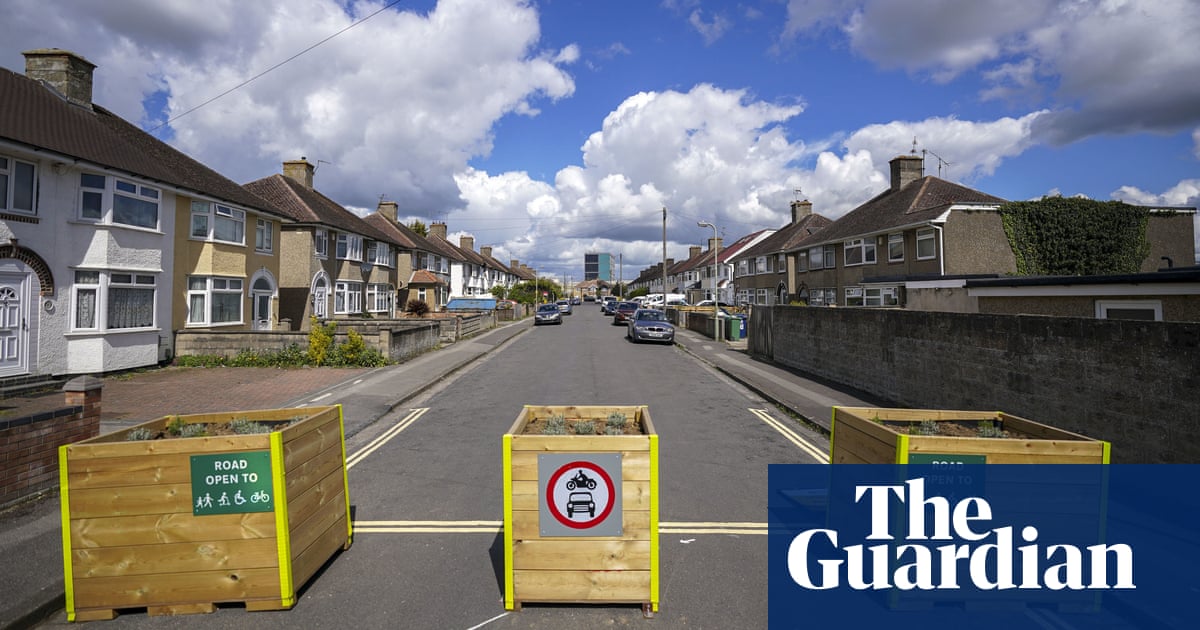
An official study of low-traffic neighbourhoods (LTNs) ordered by Rishi Sunak amid efforts to stop them being built has instead concluded they are generally popular and effective, with the report initially buried, the Guardian has learned.
The long-delayed review by Department for Transport (DfT) officials was commissioned by the prime minister last July, as Sunak sought to capitalise on controversy about the schemes by promising drivers he was “on their side”.
Downing Street had hoped the study would bolster their arguments against LTNs, which are mainly installed by Labour-run councils, but it largely points the other way.
The report, which only applies to England as transport is devolved, had been scheduled for publication in January. However, after its findings emerged, government advisers asked that it be permanently shelved, the Guardian was told.
One government source disputed this, saying the report would be published soon, and that it was “categorically not the case” that it had been suppressed.
A copy of the report seen by the Guardian said that polling carried out inside four sample LTNs for the DfT found that overall, twice as many locals supported them as were opposed.
A review of existing evidence into their effectiveness said that although formal studies were limited, they did not support the contention of opponents that LTNs simply displace traffic to other streets, rather than easing overall congestion.
“The available evidence from the UK indicates that LTNs are effective in achieving outcomes of reducing traffic volumes within their zones while adverse impacts on boundary roads appear to be limited,” it read.
The study also seems to dispel the argument that LTNs are deeply unpopular. Surveys of 1,800-plus residents in four sample schemes, in London, Birmingham, Wigan and York, found an average of 45% support against 21% opposition.
In each of these schemes, the percentage of people backing the LTNs was between 19 points and 31 points higher than the percentage opposed. In a sign that the controversy about the schemes might be largely generated by politicians and the media, 58% of people did not even know they lived in an LTN.
The report is another blow to Sunak in his attempt to attract votes by blocking schemes that encourage active travel, set out in September in a “plan for drivers”, promising a clampdown on LTNs, bus lanes and 20mph speed limits, and moves to prevent councils fining people for infractions.
As part of the latter policy it is understood that the DfT plans to launch a consultation into potentially denying councils access to centrally held data from automatic numberplate recognition cameras if it is felt they are enforcing road rules too vigorously.
In January, the Guardian revealed that the plan for drivers was guided in part by government worries about so-called 15-minute cities, an urban planning concept that has become the focus of conspiracy theories.
LTNs are modal filters, a commons traffic management tool used for decades that stops motor vehicles from using smaller, residential streets as cut-throughs, using camera-enforced signs or physical barriers, but allow full access for pedestrians and bikes.
They became controversial after a large number were installed at speed, many in London, during the Covid lockdowns of 2020, in an attempt to help people travel around more safely and easily on bike or foot.
The DfT report, which covers only schemes installed from 2020 onwards, noted that where there had been problems, for example with emergency services, this tended to be when schemes had been rushed through or were new, with the issues tending to ease over time.
While the Met police and one ambulance service reported initial problems, overall “LTNs do not adversely affect response times for emergency vehicles”, the report said.
Critics of LTNs argue they benefit people living inside them largely by pushing traffic on to nearby roads. However, the DfT said this did not seem to be the case.
“There are tensions between evidence and perceptions,” the report said. “There appears to be limited evidence of adverse impacts on boundary roads, but residents are more likely than not to think that schemes have added traffic congestion and queues to these nearby roads.”
The report found some evidence of the schemes encouraging people to walk and cycle, as well as interim findings that LTNs tended to result in a reduction in road danger and street crime, while saying more research was needed.
It did note mixed findings for people with disabilities, with some saying LTNs had made their journeys longer, while others said the opposite.
A wider survey of councils found that of 42 LTNs where the local authority responded, an average of 31,000 penalty charge notices had been issued. However, this varied wildly, ranging from 170,000 in one LTN to 83 in another.
The DfT was contacted for comment.
"low" - Google News
March 08, 2024 at 11:53PM
https://ift.tt/I7OyjDb
Rishi Sunak’s report finds low-traffic neighbourhoods work and are popular - The Guardian
"low" - Google News
https://ift.tt/eyzmRjZ
Bagikan Berita Ini














0 Response to "Rishi Sunak’s report finds low-traffic neighbourhoods work and are popular - The Guardian"
Post a Comment